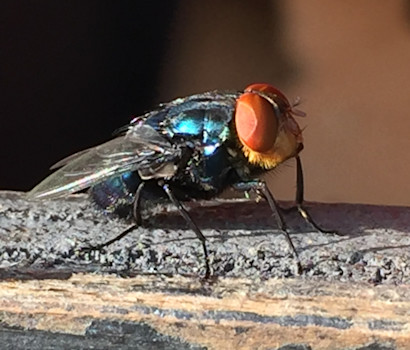New World Screwworm: What Horse Owners Need to Know
By: Liz Schatz, DVM | Updated August 20, 2025

There has been some media buzz about New World Screwworm (NWS) due to a recent outbreak in Central America and Mexico. At this time, NWS flies have not been identified in the United States, but surveillance measures have been initiated. Here’s what you need to know about this parasite as it pertains to you and your horses.
What is New World Screwworm?
New World Screwworm (Cochliomyia hominivorax) is a potentially devastating invasive fly species. Adult screwworm flies have orange eyes, a green to blue body, and three dark stripes on their backs. The adults are approximately the size of a housefly, so they can be difficult to identify. The larvae burrow into and feed on the flesh of livestock, wildlife, pets, and even humans, causing serious damage that is often fatal.
The NWS Life Cycle
- An adult screwworm fly is drawn to the smell of an open wound, where she lays her eggs.
- In only a few hours, the eggs hatch into larvae. The larvae burrow into the wound to feed on the animal, further worsening the wound and attracting more flies to the area.
- After about a week of the larvae feeding on the animal, they fall off and burrow into the ground to pupate (its next stage of development).
- Seven days later, a fully developed adult fly emerges.
Where are Screwworm Flies Found?
This species is widespread in Cuba, Haiti, the Dominican Republic, and parts of South America, but was eradicated from the United States in 1966 and again in 2017 after a regional outbreak. Surveillance and eradication programs are crucial to the protection of companion animals, livestock, the economy, and the global food supply.
Who is in Charge of Surveillance and Eradication Programs?
Surveillance and eradication of foreign animal diseases and invasive species are managed by multiple foreign and domestic agencies. NWS efforts are being handled by the:
- United States Department of Agriculture (USDA)
- Animal and Plant Health Inspection Service (APHIS)
- US Department of State
- Food and Agriculture Organization of the United Nations
- Government organizations of the affected countries
Because NWS is considered a reportable disease in the US, any suspected cases must be reported to the APHIS Area Veterinarian in Charge and the state animal health official. Those officers then investigate the suspected case and take the appropriate next steps.
How to Monitor Your Horse for a Screwworm Infection

Signs of NWS that you can look for in your horses include:
- General irritation
- Head shaking
- Nonhealing wounds with or without live maggots
- The smell of decay
If you notice any of these or if you have concerns regarding NWS flies on your property, your equine veterinarian is your best resource. If they suspect an outbreak of NWS, they will provide treatment and contact the appropriate government officials for you.
Treatment and Prognosis for Cases of NWS
In diagnosed cases of NWS, a veterinarian removes the maggots and thoroughly cleans the wounds. The wounds may be treated with insecticides, and horses are administered antibiotics if there is a secondary bacterial infection. Affected animals are also administered systemic parasite control, such as ivermectin or a similar product. Quarantining the horse may be necessary to prevent NWS from spreading to the rest of the herd.
With proper, timely treatment, horses may have a good prognosis of returning to their previous health. Owners must always pay close attention their horses, including regularly inspecting them for wounds and maintaining a clean environment to minimize flies.
Additional Resources
- Equine Disease Communication Center fact sheet on New World Screwworm
- APHIS information on NWS outbreaks.